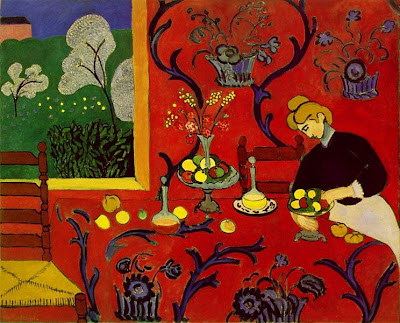Henri Matisse (1869 - 1954) was a French painter, who teamed up with Andre Derain to form the Fauvists, a group of artists who were often ridiculed and discredited by the public for their emphasis on color over the structure and perspective of a painting.

(Matisse, Henri. La Raie Verte "The Green Line." c. 1905.
Oil & tempera on canvas. Statens Musseum for Kunst, Copenhagen.)
Matisse once reflected on the significance of the years 1905 - 1907 by saying, "Fauvism is not everything, but it is the foundation of everything." Yet, in the years leading up to this breakthrough, he had despaired of ever making a living from his art.

(Matisse, Henri. Open, Window, Collioure. c. 1905.
Oil on canvas. Private Collection.)
While completing his law studies, Matisse enrolled at the Ecole des Beaux-Arts and joined the studio of Gustave Moreau. In 1898, he traveled to Corsica, where he produced small, colorful work, the precursors of Fauvism before returning to a darker palette.

(Matisse, Henri. La Dance "The Dance." c. 1910.
Oil on canvas. The State Hermitage Museum, St Petersburg.)
Matisse worked alongside the Divisionist painter Paul Signac in St. Tropez in 1904, where he produced sketches for his seminal painting
Luxe, Calme, et Volupte (Luxury, Serenity, and Pleasure), and with Andre Derain in Collioure during the "Fauve Summer" of 1905.

(Matisse, Henri. The Goldfish. c. 1912.
Oil on canvas. Pushkin Museum of Art, Moscow.)
Between 1906 and 1910, he created some of his most important pieces, affirming his belief in the importance of harmonious, brightly colored composition. Matisse frequently combined portraiture, still life, and landscape, in a way not seen before. These elements occur together in his many interior scenes in which an open window looks out onto the sea or a landscape.

(Matisse, Henri. The Dessert: Harmony in Red "The Red Room."
c. 1908. Oil on canvas. Royal Academy, London.)
Matisse was quoted as, "A work of art must carry itself in complete significance and impose it upon the beholder, even before they can identify the subject matter." I think that sums it up, his life was a continual search for balance between color and form and his work is much appreciated here!
Enjoy :)
Reference: King, R. Art. New York: DK Publishing, 2008.
_1919.jpg)











